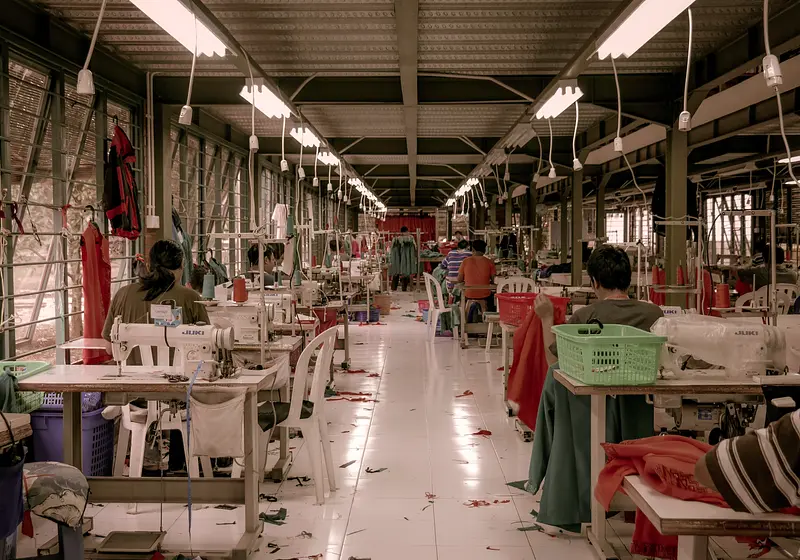Nowadays, with information available at the tap of a finger and social media being a prominent influence in our lives, it seems that fashion trends are coming and going faster than ever before. Social media sites such as Instagram and TikTok constantly feature new trends and clothes that you apparently must buy in order to feel included, leading our senses of self worth to depend on fleeting trends and beauty standards.
As well as putting unfair and unhealthy pressure on young people seeking acceptance, this also results in huge, damaging consumption of fast fashion.
What Is Fast Fashion?
Fast fashion refers to those quick and easy retailers who rapidly produce clothing, where you can quickly get on-trend, often lower quality pieces for low prices. This is a popular option in this social climate of constantly revolving styles, with the convenience and affordability appealing to the consumer. But behind this, fast fashion is truly damaging in a variety of ways.
Firstly, fast fashion is highly detrimental to the environment, which is a significant concern given the current climate crisis. Fast fashion relies on trend cycles; clothing is produced on a mass scale to quickly get to the customer, who aims to remain 'on trend'. This process damages the environment itself - did you know that fashion production is responsible for 10% of human carbon emissions?
That it takes 2,700 litres of water to produce the cotton required to make a single t-shirt? These ever-changing cycles also lead to clothes being thrown away on a mass scale, leading to landfill build ups and excessive waste.
As well as the environmental consequences, fast fashion also leads to poor working conditions in factories and sweatshops. These retailers rely on things such as child labour, and forcing workers to work in unsafe and inhumane conditions whilst paying them incredibly low salaries.
Thus, fast fashion is both an environmental and humanitarian issue, making its popularity an ethical catastrophe. Although the prominence of the fast fashion industry in our lives makes it hard to give it up completely, limiting your consumption of fast fashion can help improve the situation.
1. Invest in quality pieces
One of the issues with fast fashion is that clothes are constantly thrown away, as they go out of fashion or fall apart due to their poor quality, leading to a build up which is harmful to the planet. This is why it is important to invest in timeless, good quality pieces that you can wear for years on end. This could include things such as a plain white t shirt, a nice winter coat, or a good pair of jeans, - pretty much any piece which you know you will get significant use out of and which won't quickly go out of style.
To help you decide what to invest in, you should think about the cost per wear of the item you are contemplating buying, which follows the idea that the value of the item depends on how much you wear it. This can be done by dividing the cost of the item by the amount of times you realistically think you will wear it. So for example, say you want to purchase a winter coat that costs £40.
If you are going to wear it for, say, at least 40 days in the winter, then the low CPW suggests this is an investment worth making. But if you're only going to wear the item twice, then that £20 CPW probably indicates that it isn't worth the spend.
However, don't let CPW lead you to buy cheaper items that you'll get less use out of. Instead, let it guide your investments to make sure you are spending your hard earned cash wisely and ethically. For example, your CPW on a staple item such as a good pair of trainers is probably going to be really low if you're wearing them all the time, so you can invest more money into this item, and in return you should get better quality goods which will last you years. And if you are picking truly timeless items, you'll want to wear them for years, too!
There are many sustainable brands out there which offer good quality items of clothing that are produced in an ethical, environmentally friendly way. However, its worth bearing in mind that these brands tend to have much higher price points, and not everybody can afford these. Fast fashion and the sustainable clothing movement is a classist issue, and it needs to be remembered that many people simply can't afford to spend hundreds on their clothes; what we buy is dependent on what is within our means.
2. Shop secondhand
Buying secondhand items can be a great way to limit your consumption of fast fashion, especially if you are constantly on the hunt for new pieces, and are particularly pleased by a bargain. In the UK, our charity shops can sometimes be a bit of a let down when it comes to finding trendy or youthful items, but don't be deterred - with a bit of effort you can often find a great buy. Also, this isn't the only way to buy pre-loved clothing that you genuinely want to wear.
Sites such as Depop and eBay allow you to buy clothing online, as well as selling your own. This means that not only can you turn a profit and get your hands on some great pieces, you're also preventing unwanted clothing from ending up in landfills where they will damage the environment.
Whilst certain sellers overcharge dramatically for items, by having a good look around its likely you'll come across some absolute steals. You can also find unique vintage pieces too, meaning that limiting your fast fashion intake can actually be a crucial step in developing your own personal sense of style.
Some places will also run events called kilo sales, which allow you to get vintage and preloved clothing at really low prices. Most of the ones I've been too have charged around £15 per kilo, a bargain when you consider that you can get quality vintage pieces without contributing to environmental damage - you get to fill up bags with clothing until your hearts content (or, lets be honest, until you've run out of cash!).
3. Upcycle your old clothing
Rather than just throwing away the old pieces that you don't get much use out of anymore, think about ways in which you can give these items new life. This could be something as simple as cutting an old, shapeless pair of jeans into a pair of shorts, or a boxy old t-shirt into a crop top, refreshing the items and subsequently making you want to wear them more.
If you have sewing skills, you can get so creative with your old pieces, updating them to match your current tastes. Social media sites such as YouTube and Instagram are full of inspiration and tutorials for this.
However. if you aren't quite so skilled in textiles, there are so many other ways to customise clothing. You could get some fabric paint and decorate that old denim jacket, or cover your unworn garments with iron-on patches that you can buy from sites such as Etsy (and you'll be supporting a small business at the same time, so ultimately its a win-win situation). Get creative with it!
4. Swap clothes with friends and family
One simple, cheap way to keep your wardrobe updated and in line with your personal style is to swap clothing with your family and friends. This might be switching t-shirts with a pal, or raiding your mum's wardrobe - anything to make use of old clothing that somebody around you doesn't want anymore. This is a great solution to fast fashion - you get the feeling of having a new item, BUT its free and environmentally friendly.
If you research according to your location, some shops / organisations near you may run clothes swap events. You could even hold one yourself, for example, at your school or college. This way, you can raise awareness of fast fashion, and give people the opportunity to 'shop' in an eco-conscious way.
5. Donate or resell old clothing
Of course its unlikely that you'll never buy new items of clothing from fast fashion retailers again, which is totally understandable - taking baby steps to limit your intake of fast fashion is much more realistic, and makes the behaviours much easier to sustain. A way in which you can make this practice more ethical is by donating or reselling your old clothing once you no longer want it, as this will make sure the items go to a loving home and that their value is maximised.
Donating your clothing to a charity shop or thrift store is a great way to avoid your clothes simply being thrown away to contribute to massive landfill build ups - you get to have a clear out and dispose of unwanted items ethically, whilst the store can generate profit for a worthy charity.
Additionally, if you're strapped for cash and seeking a form of income, you could also sell on your old clothing provided it is in good condition. Platforms such as eBay and Depop are great for this purpose.
6. Do your research
Its going to be hard to limit your fast fashion consumption if you have no clue where to begin - you may have decided to shop more consciously, but where can you buy your clothes now? If you use social media to explore your options, you'll be able to find useful information which can help you. Many influencers will have ethical hauls on YouTube, or promote sustainable brands on their Instagram feeds.
Alternatively, you can use these sites to explore ways to style items - you can learn how to style your most basic pieces in a variety of ways, or rediscover a lost treasure buried deep in your wardrobe. If you can get more looks out of the clothing you own, you'll be less inclined to shop for more things, which will help to slow down the cycle of fast fashion in the long term.














.jpg)